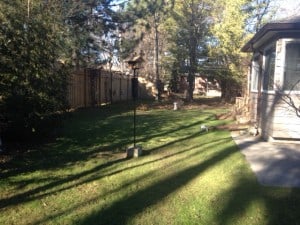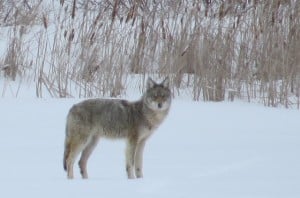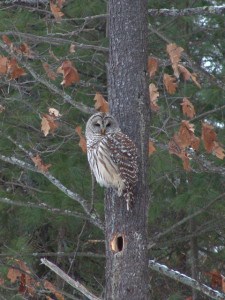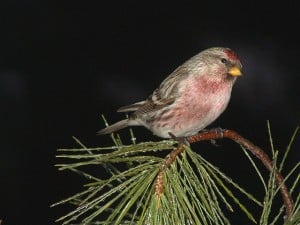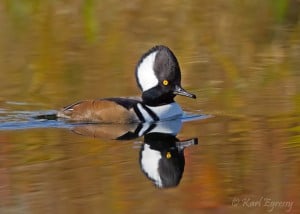Although winter’s official start was three days ago, you certainly wouldn’t know it. Peterborough has experienced unprecedented warmth this month with temperatures averaging an amazing 9 C above normal. (Note: December ended up being 7.8 C above normal – the warmest ever recorded for Peterborough and the Kawarthas.) Not surprisingly, many plants and animals don’t seem to know it’s winter, either. Skunks and raccoons, which usually sleep most of the winter, remain active; moths, ladybugs, midges, mosquitoes, and woolly bear caterpillars can still be found; ducks that are usually long gone by now continue to linger; and I’ve even come across the odd dandelion, yarrow and goldenrod in bloom. There was also a report from eastern Ontario of a wild turkey nest full of eggs. Unseasonably warm weather is also occurring across the United Kingdom where daffodils are blooming as far north as Northern Ireland. In fact, December temperatures in London have been warmer than July’s.
The question, of course, is why this is happening. According to Dave Phillips, senior climatologist at Environment Canada, an exceptionally strong El Nino is mostly to blame. Speaking to CHEX TV, Phillips said, “Water (in the Pacific Ocean) has to be a half-degree warmer than usual for several months to be declared an El Nino. Right now, it is 3.1 degrees warmer than normal. It’s a hot tub!” Axel Timmerman of the University of Hawaii in Honolulu predicts that this year’s El Niño will only grow in intensity, likely becoming the strongest ever.That energy has to go somewhere, and during an El Niño winter it spreads warmth and humidity eastward. Monsoons and trade winds are also disrupted, which causes severe storms, droughts, floods and food shortages like those that Africa is now facing. Many scientists are convinced that climate change, too, is playing a role in setting the larger stage for such a strong El Nino.
Despite all, Environment Canada assures us that colder weather will eventually arrive. As a reminder of what to watch for in nature, here are some mileposts of the winter months. If the warmth and lack of snow continue, however, abnormal occurrences such as those we’ve been seeing are certain to persist. Who knows? Tulips in February?
JANUARY
· In the first week of January, sunrise is later than at any other time of the year. In fact, the sun doesn’t peak over the horizon until 7:49 a.m. Compare this to June 20 when the sun rises at 5:29 a.m.
· Watch for ruffed grouse at dawn and dusk along tree-lined country roads. The birds often appear in silhouette as they feed on buds such as those of trembling aspen.
· Small numbers of common goldeneyes and common mergansers can be seen all winter long on the Otonabee River, at Young’s Point and at Gannon Narrows.
· White-tailed deer shed their antlers between late-December and early March. Antlers are temporary projections of bone, which are grown and discarded each year.
· Coyotes are quite vocal during their January to March mating season. The young are born 60-63 days later, usually in a ground den.
· Bass lie dormant under logs, weeds or rocks until the light and warmth of spring restore their energy and appetite.
· If you’re walking in the woods, you’ll notice that some of the smaller trees have retained many of their leaves. These are usually beech, oak, or ironwood.
· Honeybees are the only insects to maintain an elevated body temperature all winter. They accomplish this by clustering together in a thick ball within the hive, vibrating their wings to provide heat and eating stored honey for the necessary energy.
· Barred owls sometimes show up in rural backyards and prey on feeder birds or mice and voles that attracted at night by fallen seeds.
· The cones of red and white pine drop to the ground all winter long. The seeds, however, were released in the fall.
· In late January, black bears give birth to cubs no larger than chipmunks. Generally, two cubs are born, although there are sometimes as many as four or five.
FEBRUARY
· We begin the month with about 9 ¾ hours of daylight and end with 11, a gain of about 75 minutes. The lengthening days are most notable in the afternoon.
· Groundhog Day, February 2, marks the mid-point of winter. However, our groundhogs won’t see their shadow – or light of day, for that matter – until mid-March at the earliest. In case you were wondering, no animal or plant behaviour can portend upcoming weather beyond a few hours.
· Although tentative at first, bird song returns in February as pair bonds are established or renewed. Black-capped chickadees, northern cardinals, and white-breasted nuthatches are several of the birds that usually start singing this month.
· Gray squirrels mate in January or February and can often be seen streaming by in treetop chases as a group of males chases a half-terrorized female. Amazing acrobatics are usually part of the show.
· Lake trout eggs hatch in February but the fry remain in the lake bottom for about six weeks and survive on energy stored in their yolk sac.
· The Great Backyard Bird Count takes place February 12-15. This citizen science event engages bird watchers of all levels of expertise to create a real-time snapshot of the whereabouts and relative abundance of birds in mid-winter. Anyone can participate. Go to www.birdcount.org for details.
· Watch for river otters in winter around areas of flowing water. Their trough-like, snow-slide trails are often seen on embankments or even flat ground.
· Late February is courtship time for ravens. Males engage in aerial nuptial displays, diving and twisting like corkscrews over Canadian Shield country.
· The male common goldeneye puts on an elaborate courtship display in late winter. He thrusts his head forward and then moves it back towards his rump. With his bill pointing skyward, he utters a squeaky call.
· On mild, sunny, late winter days, check the snow along the edge of woodland trails for snow fleas. What looks like spilled pepper may begin to jump around right before your eyes!
· Testosterone-charged male skunks roll out of their dens any time from mid-February to early March and go on nocturnal prowls looking for females. The smell of a skunk on a damp, late winter night is a time-honoured sign of “pre-spring.”
· By month’s end, spring has sprung for overwintering monarchs in the mountains of Mexico. As lengthening days trigger the final development of the butterflies’ reproductive system, male monarchs begin zealously courting females. In December, the monarch population was estimated to be four times larger than last year’s. Great news!
MARCH
· Duck numbers increase as buffleheads and hooded mergansers start arriving.
· House sparrows are already laying claim to nest boxes. The male will often perch on the box and call repeatedly to claim real estate and attract a mate.
· Chipmunks make their first appearance above ground since late fall. They did remain somewhat active all winter, however, making repeated trips to their underground storehouses for food.
· The buds of lilac, red-berried elder, red maple, and silver maple swell this month and are much more noticeable.
· The furry catkins of pussy willows and aspens poke through bud scales and become a time-honoured sign of spring’s imminent arrival.
· By mid-March, the first northward-bound turkey vultures are usually seen. Each year, a particularly reliable group of these birds lingers for a week or more in the west end of Peterborough.
· The first songbirds, too, usually return by mid-month. In the city, the most notable new arrivals are robins and grackles. In rural areas, watch for red-winged blackbirds perched high in wetland trees.
· For anyone paying attention, the increase in bird song is hard to miss. If you don’t already know the voices of common songsters, this is a great time to start learning them. Go to allaboutbirds.org, enter the name of the species, and click on the Sound tab.
· The spring equinox occurs on March 20 as the sun shines directly on the equator. Both the moon and sun rise due east and set due west. Day and night are nearly equal in duration. For the next six months, we can enjoy days that are longer than nights.
